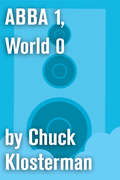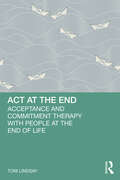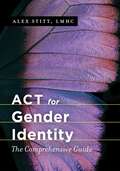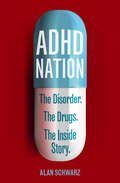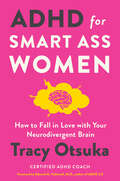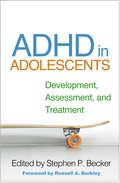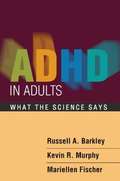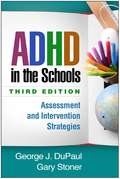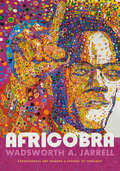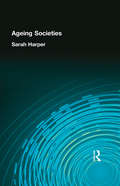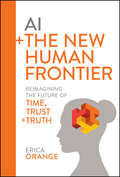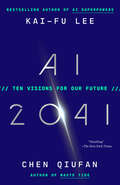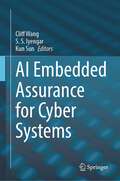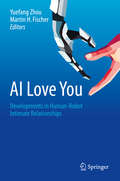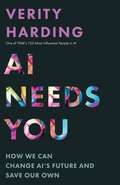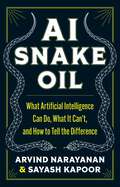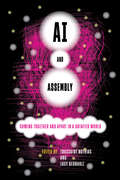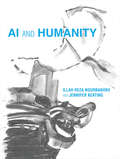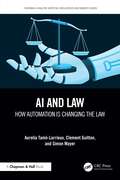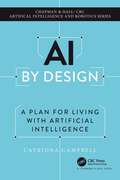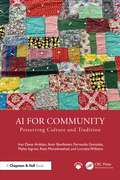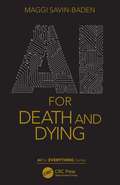- Table View
- List View
ABBA 1, World 0
by Chuck KlostermanOriginally collected in Eating the Dinosaur and now available both as a stand-alone essay and in the ebook collection Chuck Klosterman on Pop, this essay is about ABBA.
ACT at the End: Acceptance and Commitment Therapy with People at the End of Life
by Toni LindsayACT at the End is based on the principles of Acceptance and Commitment Therapy (ACT), and while it has a grounding in research, it is also a hands-on clinical guide for those working with people at a tricky and complex time of life. This treatment manual is arranged to support clinicians in stepping through common concerns and addressing the ways that people at this stage of life may require psychological support as well as strategies for supporting clinicians working in this space. The guide provides a formulated ACT approach to address each element of the Hexaflex, as well as work around self-compassion and using ACT approaches to support difficult decision making.This book provides examples that clinicians will be able to apply to their own practices and tools that they can use to troubleshoot clinical concerns. It’s a helpful companion to clinicians navigating challenging terrain—much in the way that someone might turn to a colleague for advice, it is open and accessible, while still recognizing the ways in which that the work is hard.
ACT for Gender Identity: The Comprehensive Guide
by Alex StittIncreasingly adopted by therapists and mental health professionals, Acceptance and Commitment Therapy (ACT) helps clients to cope with social, emotional and mental health issues by using the six core ACT processes: Acceptance, Cognitive Defusion, Being Present, the Self as Context, Values and Committed Action.This is the go-to-guide for evidence-based ACT techniques to be used by professionals to help their transgender, genderqueer, genderfluid, third gender and agender clients. It provides the tools to help these clients develop emotional processing skills they can implement throughout their life, from coping with mental health issues and substance abuse, to navigating prejudice and social pressure, to building a career and developing a family.
ADHD Nation: The disorder. The drugs. The inside story.
by Alan SchwarzAttention Deficit Hyperactivity Disorder (ADHD) will soon be the most frequently diagnosed chronic condition among children, surpassing asthma. Yet research shows that ADHD can't be that prevalent. ADHD, a problem once thought to affect a small percentage of children, has exploded into one of the most misdiagnosed psychiatric conditions. Now doctors and Big Pharma are targeting children and adults worldwide to get the diagnosis and take medications that will, they say, transform their lives. In ADHD Nation, acclaimed New York Times journalist Alan Schwarz takes readers behind the scenes to tell the full story of this billion-dollar industry. There's the father of ADHD, Dr Keith Conners, who spent fifty years promoting the disorder in the US and pills like Ritalin before realising just what he had wrought; a troubled young girl and studious, teenage boy who get entangled in the ADHD machine and are prescribed medications that lead to serious problems; and the pharmaceutical industry that promoted the disorder and continues to earn billions from the rampant mishandling of ADHD. An investigation of how Big Pharma and medical professionals are complicit in the creation, maintenance and continuing expansion of the ADHD industry, this book sounds the alarm for UK readers and demands we wake up to the problem that we too could face in the future.
ADHD for Smart Ass Women: How to Fall in Love with Your Neurodivergent Brain
by Tracy OtsukaAn unprecedented guide for any woman with ADHD looking to celebrate her unique brilliance and to embark on a journey of self-discovery. ADHD is one of the most common neurological disorders in the United States—yet a staggering 75 percent of girls and women remain undiagnosed. Due to the gender gap in medical research, which does not account for symptoms manifesting differently in women—leading to increased problems with anxiety, depression, working memory, sleep, energy, and concentration—many ADHD women are left to navigate a society that fails to understand their struggles and gifts. But what if every woman had the resources and support to uncover the hidden wonders of her neurodivergent brain?Enter certified ADHD coach and podcast host Tracy Otsuka. Armed with her experience coaching thousands of women, cutting-edge medical research, and personal insights from her own diagnosis, she presents a revelatory guide tailored specifically for girls and women with ADHD. In it, Otsuka offers an entirely new set of tools, systems, and strategies to access a world of boundless productivity, focus, and confidence.With her signature wit and levity—in entertaining chapters designed for ADHD readers—Otsuka explores the unique challenges that ADHD women face and illuminates the extraordinary qualities that set them apart: overflowing creativity, laser-focused attention, deep empathy, and fearless entrepreneurial spirit. Even without an official diagnosis, readers will be equipped with the tools to conquer any to-do list and to tap into their true purpose, personally or professionally.By dismantling the long-standing stereotypes and misinformation surrounding women with ADHD, Otsuka offers a beacon of hope for any woman looking to transform her symptoms into strengths. Comprehensive, lively, and long overdue, ADHD for Smart Ass Women is the key to unlocking unparalleled potential and to understanding your truly magnificent and brilliant brain. Are you ready to discover your superpower?
ADHD in Adolescents: Development, Assessment, and Treatment
by Stephen P. BeckerBringing together leading authorities, this much-needed volume synthesizes current knowledge about the nature, impact, and treatment of attention-deficit/hyperactivity disorder (ADHD) in the crucial developmental period of adolescence. Contributors explore the distinct challenges facing teens with ADHD as they navigate intensifying academic demands; new risks in the areas of driving, substance use, and romantic relationships; and co-occurring mental health problems. Best practices in clinical assessment are presented. Chapters on treatment--several of which include illustrative case examples--review interventions targeting motivation, executive functioning, and homework problems, as well as applications of cognitive-behavioral therapy and mindfulness. The book also examines medication issues specific to this age group.
ADHD in Adults: What the Science Says
by Kevin Murphy Russell BarkleyProviding a new perspective on ADHD in adults, this compelling book analyzes findings from two major studies directed by leading authority Russell A. Barkley. Groundbreaking information is presented on the significant impairments produced by the disorder across major functional domains and life activities, including educational outcomes, work, relationships, health behaviors, and mental health. Thoughtfully considering the treatment implications of these findings, the book also demonstrates that existing diagnostic criteria do not accurately reflect the way ADHD is experienced by adults, and points the way toward developing better criteria that center on executive function deficits. Accessible tables, figures, and sidebars encapsulate the study results and methods.
ADHD in the Schools, Third Edition
by Robert Reid George J. Dupaul Gary StonerThis highly regarded practitioner guide provides state-of-the-art tools for supporting the academic and behavioral success of K-12 students with attention-deficit/hyperactivity disorder (ADHD). The authors explain the learning and behavior difficulties associated with ADHD and describe screening and assessment procedures that facilitate data-based decision making. They show how to develop individualized intervention plans that integrate behavioral, academic, and social supports, in partnership with teachers and parents. Strategies for collaborating with physicians and monitoring students' medication response are also presented. Helpful reproducible forms and handouts can be downloaded and printed in a convenient 8 1/2" x 11" size. New to This Edition: *Reflects a decade's worth of research and clinical advances, plus the growth of multi-tiered service delivery models. *Discusses changes in DSM-5. *Separate chapter on interventions for middle and high school students, with new content on the transition to college. *Updated medication information, case examples, and more.
ADHD in the Schools, Third Edition: Assessment and Intervention Strategies
by Robert Reid George J. Dupaul Gary StonerThis highly regarded practitioner guide provides state-of-the-art tools for supporting the academic and behavioral success of PreK-12 students with attention-deficit/hyperactivity disorder (ADHD). The authors explain the learning and behavior difficulties associated with ADHD and describe screening and assessment procedures that facilitate data-based decision making. They show how to develop individualized intervention plans that integrate behavioral, academic, and social supports, in partnership with teachers and parents. Strategies for collaborating with physicians and monitoring students' medication response are also presented. Helpful reproducible forms and handouts can be downloaded and printed in a convenient 8 1/2" x 11" size. New to This Edition: *Reflects a decade's worth of research and clinical advances, plus the growth of multi-tiered service delivery models. *Discusses changes in DSM-5. *Separate chapter on interventions for middle and high school students, with new content on the transition to college. *Updated medication information, case examples, and more.
AFRICOBRA: Experimental Art toward a School of Thought (Art History Publication Initiative)
by Wadsworth A. JarrellFormed on the South Side of Chicago in 1968 at the height of the civil rights, Black power, and Black arts movements, the AFRICOBRA collective created a new artistic visual language rooted in the culture of Chicago's Black neighborhoods. The collective's aesthetics, especially the use of vibrant color, capture the rhythmic dynamism of Black culture and social life. In AFRICOBRA, painter, photographer, and collective cofounder Wadsworth A. Jarrell tells the definitive story of the group's creation, history, and artistic and political principles. From accounts of the painting of the groundbreaking Wall of Respect mural and conversations among group members to documentation of AFRICOBRA's exhibits in Chicago, New York, and Boston, Jarrell outlines how the collective challenged white conceptions of art by developing an artistic philosophy and approach wholly divested of Western practices. Featuring nearly one hundred color images of artworks, exhibition ephemera, and photographs, this book is at once a sourcebook history of AFRICOBRA and the story of visionary artists who rejected the white art establishment in order to create uplifting art for all Black people.
AGEING SOCIETIES: A Multi-disciplinary Approach (A\hodder Arnold Publication)
by Sarah HarperDemographic ageing is a reality - within 25 years half the population of Western Europe will be over 50, one quarter over 65, and the Less Developed Countries will contain one billion elderly people. Ageing Societies examines the myths, challenges and opportunities behind these figures. Ageing Societies explores three areas:§ the growing necessity for extending economic activity into later life and the implications of societal ageing for the intergenerational contract and the provision of social security § the changes in modern families and the implications the changes have for the provision of support and care for the ageing population § the biggest demographic challenge of all: ageing in the Less Developed Countries where there is little or no infrastructure to provide long-term care or social security.Combining bio-demography, sociology, economics and development studies, Ageing Societies highlights the opportunities of an ageing population for a mature society. Age-integrated and flexible workforces, increased labour mobility, intergenerational integration, age equality and politically stable age-integrated societies are the potential benefits of a demography which will be with us for the majority of this century.
AGS Economics: Learning About Our United States
by Carol Sullivan Jane Wilcox SmithThese six worktexts combine easy-to-read information with summaries, exercises, and activities. Worktexts cover the following topics: Economics, Geography of the United States, United States Citizenship, Exploring American History, You and the Law, & Learning About Government.
AI + The New Human Frontier: Reimagining the Future of Time, Trust + Truth
by Erica OrangeA critical discussion of AI as a transformative opportunity for humanity AI + The New Human Frontier: Reimagining the Future of Time, Trust + Truth by Erica Orange, a renowned futurist, offers a compelling exploration of generative AI's potential to enhance human creativity rather than replace it. This pivotal book navigates how AI tools will help shape the human experience, and aid in augmenting human ingenuity and imagination. The author eloquently argues that the essence of human intelligence—our curiosity, critical thinking, empathy, and more—is not only irreplaceable but will become increasingly valuable as AI evolves to take on routine tasks. AI + the New Human Frontier is a clarion call for embedding trust, human oversight and judgement into AI development, ensuring that the technology amplifies our most human capabilities. At a time when the lines between what is real, fake, true and false are becoming more blurred, reliance on human-centric solutions, not just technological ones, will become more critical. Why AI + The New Human Frontier is a must-read: Navigate the Future with Confidence: Prepare yourself for the future with groundbreaking perspectives on the relationship between humans and AI. Find out how to futureproof against the challenges of tomorrow and seize the opportunities presented by technological advancements. Understand how to capitalize on the Potential of AI: Learn how the next generation of AI tools can expand human creativity and intelligence, not diminish it. Discover the crucial role of human oversight in creating AI technologies that enhance our capabilities and work alongside us. Amplify Your Ability to leverage the human advantage: Understand why and how AI's advancement will make human intuition, empathy, and critical thinking more essential than ever. Get insights into how to leverage your most human-centric skills in an AI-driven world. Perfect for business leaders, managers, executives, and professionals navigating the new landscape of technology, AI + The New Human Frontier provides not only a vision of the future but also practical advice on thriving in an AI-enhanced world. Add this book to your library to ensure you're ready for the transformative changes that lie ahead.
AI 2041: Ten Visions for Our Future
by Kai-Fu Lee Chen QiufanHow will AI change our world within twenty years? A pioneering technologist and acclaimed writer team up for a &“dazzling&” (The New York Times) look at the future that &“brims with intriguing insights&” (Financial Times). This edition includes a new foreword by Kai-Fu Lee. A BEST BOOK OF THE YEAR: The Wall Street Journal, The Washington Post, Financial Times Long before the advent of ChatGPT, Kai-Fu Lee and Chen Qiufan understood the enormous potential of artificial intelligence to transform our daily lives. But even as the world wakes up to the power of AI, many of us still fail to grasp the big picture. Chatbots and large language models are only the beginning. In this &“inspired collaboration&” (The Wall Street Journal), Lee and Chen join forces to imagine our world in 2041 and how it will be shaped by AI. In ten gripping, globe-spanning short stories and accompanying commentary, their book introduces readers to an array of eye-opening settings and characters grappling with the new abundance and potential harms of AI technologies like deep learning, mixed reality, robotics, artificial general intelligence, and autonomous weapons.
AI Embedded Assurance for Cyber Systems
by Cliff Wang S. S. Iyengar Kun SunThe rapid growth and reliance on cyber systems have permeated our society, government, and military which is demonstrated in this book. The authors discuss how AI-powered cyber systems are designed to protect against cyber threats and ensure the security and reliability of digital systems using artificial intelligence (AI) technologies. As AI becomes more integrated into various aspects of our lives, the need for reliable and trustworthy AI systems becomes increasingly important. This book is an introduction to all of the above-mentioned areas in the context of AI Embedded Assurance for Cyber Systems.This book has three themes. First, the AI/ML for digital forensics theme focuses on developing AI and ML powered forensic tools, techniques, software, and hardware. Second, the AI/ML for cyber physical system theme describes that AI/ML plays an enabling role to boost the development of cyber physical systems (CPS), especially in strengthening the security and privacy of CPS. Third, the AI/ML for cyber analysis theme focuses on using AI/ML to analyze tons of data in a timely manner and identify many complex threat patterns. This book is designed for undergraduates, graduate students in computer science and researchers in an interdisciplinary area of cyber forensics and AI embedded security applications. It is also useful for practitioners who would like to adopt AIs to solve cyber security problems.
AI Love You: Developments in Human-Robot Intimate Relationships
by Martin H. Fischer Yuefang ZhouUsing an interdisciplinary approach, this book explores the emerging topics and rapid technological developments of robotics and artificial intelligence through the lens of the evolving role of sex robots, and how they should best be designed to serve human needs. An international panel of authors provides the most up-to-date, evidence-based empirical research on the potential sexual applications of artificial intelligence. Early chapters discuss the objections to sexual activity with robots while also providing a counterargument to each objection. Subsequent chapters present the implications of robot sex as well as the security and data privacy issues associated with sexual interactions with artificial intelligence. The book concludes with a chapter highlighting the importance of a scientific, multidisciplinary approach to the study of human - robot sexuality. Topics featured in this book include: The Sexual Interaction Illusion Model. The personal companion system, Harmony, designed by Realbotix™. An exposition of the challenges of personal data control and protection when dealing with artificial intelligence. The current and future technological possibilities of projecting three-dimensional holograms. Expert discussion notes from an international workshop on the topic. AI Love You will be of interest to academic researchers in psychology, robotics, ethics, medical science, sociology, gender studies as well as clinicians, policy makers, and the business sector.
AI Needs You: How We Can Change AI's Future and Save Our Own
by Verity HardingA humanist manifesto for the age of AIArtificial intelligence may be the most transformative technology of our time. As AI&’s power grows, so does the need to figure out what—and who—this technology is really for. AI Needs You argues that it is critical for society to take the lead in answering this urgent question and ensuring that AI fulfills its promise.Verity Harding draws inspiring lessons from the histories of three twentieth-century tech revolutions—the space race, in vitro fertilization, and the internet—to empower each of us to join the conversation about AI and its possible futures. Sharing her perspective as a leading insider in technology and politics, she rejects the dominant narrative, which often likens AI&’s advent to that of the atomic bomb. History points the way to an achievable future in which democratically determined values guide AI to be peaceful in its intent; to embrace limitations; to serve purpose, not profit; and to be firmly rooted in societal trust.AI Needs You gives us hope that we, the people, can imbue AI with a deep intentionality that reflects our best values, ideals, and interests, and that serves the public good. AI will permeate our lives in unforeseeable ways, but it is clear that the shape of AI&’s future—and of our own—cannot be left only to those building it. It is up to us to guide this technology away from our worst fears and toward a future that we can trust and believe in.
AI Snake Oil: What Artificial Intelligence Can Do, What It Can’t, and How to Tell the Difference
by Arvind Narayanan Sayash KapoorFrom two of TIME&’s 100 Most Influential People in AI, what you need to know about AI—and how to defend yourself against bogus AI claims and productsConfused about AI and worried about what it means for your future and the future of the world? You&’re not alone. AI is everywhere—and few things are surrounded by so much hype, misinformation, and misunderstanding. In AI Snake Oil, computer scientists Arvind Narayanan and Sayash Kapoor cut through the confusion to give you an essential understanding of how AI works and why it often doesn&’t, where it might be useful or harmful, and when you should suspect that companies are using AI hype to sell AI snake oil—products that don&’t work, and probably never will.While acknowledging the potential of some AI, such as ChatGPT, AI Snake Oil uncovers rampant misleading claims about the capabilities of AI and describes the serious harms AI is already causing in how it&’s being built, marketed, and used in areas such as education, medicine, hiring, banking, insurance, and criminal justice. The book explains the crucial differences between types of AI, why organizations are falling for AI snake oil, why AI can&’t fix social media, why AI isn&’t an existential risk, and why we should be far more worried about what people will do with AI than about anything AI will do on its own. The book also warns of the dangers of a world where AI continues to be controlled by largely unaccountable big tech companies.By revealing AI&’s limits and real risks, AI Snake Oil will help you make better decisions about whether and how to use AI at work and home.
AI and Assembly: Coming Together and Apart in a Datafied World
by Toussaint Nothias and Lucy BernholzArtificial intelligence has moved from the lab into everyday life and is now seemingly everywhere. As AI creeps into every aspect of our lives, the data grab required to power AI also expands. People worldwide are tracked, analyzed, and influenced, whether on or off their screens, inside their homes or outside in public, still or in transit, alone or together. What does this mean for our ability to assemble with others for collective action, including protesting, holding community meetings and organizing rallies ? In this context, where and how does assembly take place, and who participates by choice and who by coercion? AI and Assembly explores these questions and offers global perspectives on the present and future of assembly in a world taken over by AI. The contributors analyze how AI threatens free assembly by clustering people without consent, amplifying social biases, and empowering authoritarian surveillance. But they also explore new forms of associational life that emerge in response to these harms, from communities in the US conducting algorithmic audits to human rights activists in East Africa calling for biometric data protection and rideshare drivers in London advocating for fair pay. Ultimately, AI and Assembly is a rallying cry for those committed to a digital future beyond the narrow horizon of corporate extraction and state surveillance.
AI and Humanity (The\mit Press Ser.)
by Illah Reza Nourbakhsh Jennifer KeatingAn examination of the implications for society of rapidly advancing artificial intelligence systems, combining a humanities perspective with technical analysis; includes exercises and discussion questions.AI and Humanity provides an analytical framing and a common language for understanding the effects of technological advances in artificial intelligence on society. Coauthored by a computer scientist and a scholar of literature and cultural studies, it is unique in combining a humanities perspective with technical analysis, using the tools of literary explication to examine the societal impact of AI systems. It explores the historical development of these technologies, moving from the apparently benign Roomba to the considerably more sinister semi-autonomous weapon system Harpy. The book is driven by an exploration of the cultural and etymological roots of a series of keywords relevant to both AI and society. Works examined range from Narrative of the Life of Frederick Douglass, given a close reading for its themes of literacy and agency, to Simon Head's critique of the effects of surveillance and automation on the Amazon labor force in Mindless.Originally developed as a textbook for an interdisciplinary humanities-science course at Carnegie Mellon, AI & Humanity offers discussion questions, exercises (including journal writing and concept mapping), and reading lists. A companion website provides updated resources and a portal to a video archive of interviews with AI scientists, sociologists, literary theorists, and others.
AI and Law: How Automation is Changing the Law (Chapman & Hall/CRC Artificial Intelligence and Robotics Series)
by Aurelia Tamo-Larrieux Clement Guitton Simon MayerThis book provides insights into how AI is changing legal practice, government processes, and individuals’ access to those processes, encouraging each of us to consider how technological advances are changing the legal system. Particularly, and distinct from current debates on how to regulate AI, this books focuses on how the progressive merger between computational methods and legal rules changes the very structure and application of the law itself.We investigate how automation is changing the legal analysis, legal rulemaking, legal rule extraction, and application of legal rules and how this impacts individuals, policymakers, civil servants, and society at large. We show through many examples that a debate on how automation is changing the law is needed, which must revolve around the democratic legitimacy of the automation of legal processes, and be informed by the technical feasibility and tradeoffs of specific endeavors.
AI by Design: A Plan for Living with Artificial Intelligence (Chapman & Hall/CRC Artificial Intelligence and Robotics Series)
by Catriona CampbellThis book introduces the reader to Artificial Intelligence and its importance to our future. Campbell uses behavioural psychology, explores technology, economics, real-life and historical examples to predict five future scenarios with AI. Illustrating through speculative fiction, she describes possible futures after AI exceeds human capabilities. We are at a tipping point in history and must plan to ensure a successful co-existence with artificial intelligence. This book explains how to design for a future with AI so that, rather than herald our downfall, it helps us achieve a new renaissance.
AI for Community: Preserving Culture and Tradition
by Fernando Gonzalez Iran Davar Ardalan Amir Banifatemi Myles Ingram Reza Moradinezhad Lucretia WilliamsAI for Community explores the transformative potential of technology to bridge cultural divides and responsibly preserve cultural heritage, while thoughtfully considering how to ensure fairness without any ideological or cultural bias. It acknowledges the need for careful scrutiny of traditions so that artificial intelligence (AI) systems can promote comprehensive cultural understanding. This approach underscores the promise of AI as a tool for human flourishing.Authored by a multigenerational, multicultural team, this book presents real‑world examples and ethical insights that are timely, actionable, and deeply human‑centered. It introduces pioneering projects like the Indigenous Knowledge Graph, which documented ancestral wisdom; Howard University’s Project Elevate Black Voices, funded by Google, which enhanced speech recognition for African American Vernacular English (AAVE); and Laleh AI, which posthumously preserves the insights of a progressive female Islamic thinker. Also, initiatives like UNESCO’s work on cultural heritage preservation and NVIDIA’s collaboration with Te Hiku Media to safeguard the Māori language showcase AI’s vital role in reviving endangered languages.This book interweaves "Community Voices" sections between chapters, featuring interviews that explore the role and implementation of AI in new arenas. Each chapter is also supported by online resources, accessible as podcasts, videos, and articles, that provide multimedia ways to deepen understanding of culturally aware AI.AI for Community highlights how community‑driven language preservation, storytelling, and inclusive design can empower cultures and protect their heritage. This book is a vital resource for those seeking to create AI that respects and uplifts communities.
AI for Death and Dying (AI for Everything)
by Maggi Savin-BadenWhat is artificial intelligence (AI)? How does AI affect death matters and the digital beyond? How are death and dying handled in our digital age? AI for Dying and Death covers a broad range of literature, research and challenges around this topic. It explores ethical memorisation, digital legacies and bereavement, post death avatars and AI and the digital beyond. It also analyzes religious perspectives on AI for death and dying, and planning for death in a digital age. Maggi Savin-Baden is a Professor of Education at the University of Worcester and has researched and evaluated staff and student experiences of learning for over 20 years and gained funding in this area (Leverhulme Trust, JISC, Higher Education Academy, MoD). She has a strong publication record of over 50 research publications and 17 books which reflect her research interests on the impact of innovative learning, digital fluency, cyber-influence, pedagogical agents, qualitative research methods and problem-based learning. In her spare time, she runs, bakes, climbs and attempts triathalons.
